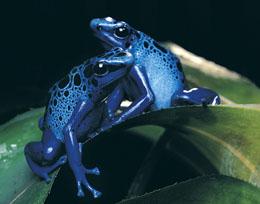 Frogs aren't always the first to suffer from pollution.Digital Vision
Frogs aren't always the first to suffer from pollution.Digital VisionPosted on 10/30/2009 12:06:37 PM PDT by neverdem
Long-standing 'canary in the coal mine' role questioned.
 Frogs aren't always the first to suffer from pollution.Digital Vision
Frogs aren't always the first to suffer from pollution.Digital VisionThe health of amphibians is commonly used to give a rough assessment of pollution levels in an area, but an analysis of more than 20,000 toxicity studies now suggests that these creatures are relatively resilient and not well suited to the task.
The finding could have a significant effect on the way that the environment is assessed. Conventional wisdom suggests that if an amphibian population is thriving, the area is probably clear of pollutants. But the survey shows that other species, such as shelled aquatic animals called brachiopods, may be better suited to monitoring contaminants.
Amphibians are believed to be sensitive to pollutants because of their highly permeable skins, and their varied lives, which maximize their exposure: they dwell on land and water, and eat both plants and animals at various stages of their life cycles1. However, studies that have looked at how amphibians compare with other animals in their susceptibility to environmental changes have not been able to prove that they are any more vulnerable than other species2,3.
To investigate how resilient amphibians really are, Jake Kerby at the University of South Dakota in Vermillion and his colleagues analysed more than 28,000 studies from the US Environmental Protection Agency's Aquatic Information Retrieval (AQUIRE) database (part of its ECOTOX system), detailing the effects of various chemical agents on aquatic species, including insects, bivalves, fish and amphibians. The team found 23,942 studies of 73 chemicals that had been tested on amphibians and many other creatures, totalling 1,075 species.
They broke the chemicals down into four categories: heavy metals, inorganic compounds, phenols and pesticides, and found that amphibians were much less sensitive to chemical exposure from heavy metals, inorganics, and pesticides than many other species. The most sensitive group proved to be brachiopods, which declined dramatically in the presence of heavy metals and inorganic chemicals. Insects, unsurprisingly, were the most sensitive to insecticides, whereas amphibians were most sensitive only to the phenol chemicals. The results appear in Ecology Letters4.
"Based on these findings the presence of amphibians at a site is not a reliable indicator that the site is free of impact," says Kerby. He explains that the loss of invertebrate biodiversity that comes before amphibians die off may be going undetected. "It is easy for people to notice the decline of something as charismatic as a frog. It is much harder to notice the disappearance of freshwater mussels," he says.
"The data are quite striking", says Sharon Lawler, an aquatic ecologist at the University of California, Davis. "it is intriguing to consider the idea that amphibians are more like miners in a coal mine than canaries. Like miners, they are sensitive to contaminants, but they may not be the first to show symptoms."
This work "overturns the common view that amphibians are, on average, more sensitive to environmental contaminants than other organisms", says Michael Benard at Case Western Reserve University in Cleveland, Ohio. "Hopefully, this work will lead to more effective regulation of contaminants that takes into account the diverse sensitivities of different organisms."
Even though amphibians did not show high sensitivities to all pollutants, they are far from useless as pollution indicators, points out environmental toxicologist Rick Relyea at the University of Pittsburgh, Pennsylvania. Amphibians certainly seem to be poor indicators of contaminant effects on invertebrates, but they may be much more effective at foreshadowing the decline of fellow vertebrate species, including humans. "We don't have an answer yet," he says.
"A study like this will help us determine which species to most closely watch," says Steven Bradbury, deputy director of the office of pesticide programmes at the Environmental Protection Agency in Washington, DC. He adds that wherever possible, the agency already monitors more than just amphibians to assess contamination in a particular area.
The finding should not downplay the need for amphibian conservation, adds Claude Gascon, executive vice-president and co-chair of the amphibian specialist group at Conservation International in Arlington, Virginia. "Red List data still show that amphibians have the highest incidence of threat and that cannot be ignored," he says. "With their noted sensitivities to ultra-violet light, habitat destruction, disease, and climate change, amphibians are dying a death by a thousand cuts. Amphibians still give a comprehensive picture of the global environment that we need to consider."
Another environazi has to plug climate change. How did all of these critters ever survive all the ice ages and subsequent interglacials such as the one we are currently enjoying?
Also.. the missing/malformed limbs... dragonfly larvae along with a couple other aquatic invasive species are chewing on a larger number of tadpoles
The extra limbs grow from the same bud areas that the bugs chew off.
I did not know that they could bud like potatoes.
My neighbor has a lizard that’s regrowing its tail, but I thought amphibians were limited to that.
Amazing.
Bad driving may have genetic basis, UCI study finds
A reasonable assessment of the swine flu vaccine Don't let the "Religion Forum" fool you. It's fairly detailed and technical.
FReepmail me if you want on or off my health and science ping list.
The Ice Age(s) were quite devastating. Earthworms have still not returned to Minnesota!
Disclaimer: Opinions posted on Free Republic are those of the individual posters and do not necessarily represent the opinion of Free Republic or its management. All materials posted herein are protected by copyright law and the exemption for fair use of copyrighted works.